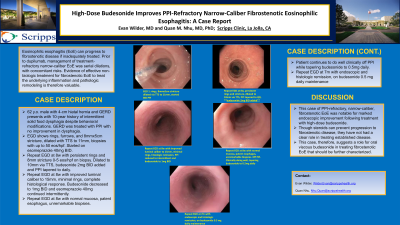Tuesday Poster Session
Category: Esophagus
P3283 - High-Dose Budesonide Improves PPI-Refractory Narrow-Caliber Fibrostenotic Eosinophilic Esophagitis: A Case Report
Tuesday, October 24, 2023
10:30 AM - 4:00 PM PT
Location: Exhibit Hall

Has Audio

Evan Wilder, MD
Scripps Green/Scripps Clinic
San Diego, CA
Presenting Author(s)
Evan Wilder, MD1, Quan M.. Nhu, MD, PhD2
1Scripps Green/Scripps Clinic, San Diego, CA; 2Scripps Clinic & Scripps Research Institute, La Jolla, CA
Introduction: Eosinophilic esophagitis (EoE) can progress through a spectrum, ultimately leading to fibrostenotic disease if left untreated or inadequately controlled. Standard medical treatment for narrow-caliber fibrostenotic EoE has historically been relatively ineffective. Prior to dupilumab, management of treatment-refractory narrow-caliber EoE was serial esophageal dilations, with concomitant risks. Evidence of effective non-biologic medical therapy of fibrostenotic EoE to treat the underlying chronic inflammation and pathologic remodeling is therefore valuable.
Case Description/Methods: A 62-year-old man with a 4-cm hiatal hernia and GERD presents with a 10-year history of intermittent solid food dysphagia despite behavioral modifications. He imbibes fluids with meals. GERD was previously treated with esomeprazole without improvement of dysphagia. Initial esophagogastroduodenoscopy (EGD) showed esophageal rings, furrows and an 8-mm wide by 5cm long stricture status post through-the-scope (TTS) balloon dilation to 11mm. Peak esophageal eosinophil count was 50/hpf. He was started on high-dose esomeprazole twice daily. Repeat EGD at 8 weeks continued to demonstrate edema, loss of vascularity, furrowing, rings, and persistent 8-mm caliber esophagus with severe strictures, despite histologic remission with 0-5 eosinophils/hpf. Dilation with TTS balloon to 10-mm with pull through showed dilation effects in several areas. Esomeprazole was continued, then switched to high-dose oral viscous budesonide 2 mg twice daily once insurance approval issues resolved. Repeat EGD at 8 weeks demonstrated dramatic improvement in luminal diameter to 15-mm, with minimal rings and furrowing, and complete histologic response. Budesonide was decreased to 1 mg twice daily, and esomeprazole was resumed at 40 mg daily for concomitant GERD symptoms. Repeat EGD at 8 weeks showed normal mucosa and patent esophagus, with unremarkable biopsies. The patient continued to do well clinically while tapering budesonide to 0.5 mg daily. Repeat EGD 7 months later demonstrated endoscopic and histologic remission.
Discussion: This case of PPI-refractory, narrow-caliber, fibrostenotic EoE was notable for marked endoscopic improvement following treatment with high-dose budesonide. Though steroids can prevent progression to fibrostenotic disease, they have not had a clear role in treating established disease. This case, therefore, suggests a role for oral viscous budesonide in treating fibrostenotic EoE that should be further characterized.
Disclosures:
Evan Wilder, MD1, Quan M.. Nhu, MD, PhD2. P3283 - High-Dose Budesonide Improves PPI-Refractory Narrow-Caliber Fibrostenotic Eosinophilic Esophagitis: A Case Report, ACG 2023 Annual Scientific Meeting Abstracts. Vancouver, BC, Canada: American College of Gastroenterology.
1Scripps Green/Scripps Clinic, San Diego, CA; 2Scripps Clinic & Scripps Research Institute, La Jolla, CA
Introduction: Eosinophilic esophagitis (EoE) can progress through a spectrum, ultimately leading to fibrostenotic disease if left untreated or inadequately controlled. Standard medical treatment for narrow-caliber fibrostenotic EoE has historically been relatively ineffective. Prior to dupilumab, management of treatment-refractory narrow-caliber EoE was serial esophageal dilations, with concomitant risks. Evidence of effective non-biologic medical therapy of fibrostenotic EoE to treat the underlying chronic inflammation and pathologic remodeling is therefore valuable.
Case Description/Methods: A 62-year-old man with a 4-cm hiatal hernia and GERD presents with a 10-year history of intermittent solid food dysphagia despite behavioral modifications. He imbibes fluids with meals. GERD was previously treated with esomeprazole without improvement of dysphagia. Initial esophagogastroduodenoscopy (EGD) showed esophageal rings, furrows and an 8-mm wide by 5cm long stricture status post through-the-scope (TTS) balloon dilation to 11mm. Peak esophageal eosinophil count was 50/hpf. He was started on high-dose esomeprazole twice daily. Repeat EGD at 8 weeks continued to demonstrate edema, loss of vascularity, furrowing, rings, and persistent 8-mm caliber esophagus with severe strictures, despite histologic remission with 0-5 eosinophils/hpf. Dilation with TTS balloon to 10-mm with pull through showed dilation effects in several areas. Esomeprazole was continued, then switched to high-dose oral viscous budesonide 2 mg twice daily once insurance approval issues resolved. Repeat EGD at 8 weeks demonstrated dramatic improvement in luminal diameter to 15-mm, with minimal rings and furrowing, and complete histologic response. Budesonide was decreased to 1 mg twice daily, and esomeprazole was resumed at 40 mg daily for concomitant GERD symptoms. Repeat EGD at 8 weeks showed normal mucosa and patent esophagus, with unremarkable biopsies. The patient continued to do well clinically while tapering budesonide to 0.5 mg daily. Repeat EGD 7 months later demonstrated endoscopic and histologic remission.
Discussion: This case of PPI-refractory, narrow-caliber, fibrostenotic EoE was notable for marked endoscopic improvement following treatment with high-dose budesonide. Though steroids can prevent progression to fibrostenotic disease, they have not had a clear role in treating established disease. This case, therefore, suggests a role for oral viscous budesonide in treating fibrostenotic EoE that should be further characterized.
Disclosures:
Evan Wilder indicated no relevant financial relationships.
Quan Nhu: Regeneron – Advisory Committee/Board Member, Speakers Bureau. Sanofi – Advisory Committee/Board Member, Speakers Bureau. Takeda – Advisory Committee/Board Member.
Evan Wilder, MD1, Quan M.. Nhu, MD, PhD2. P3283 - High-Dose Budesonide Improves PPI-Refractory Narrow-Caliber Fibrostenotic Eosinophilic Esophagitis: A Case Report, ACG 2023 Annual Scientific Meeting Abstracts. Vancouver, BC, Canada: American College of Gastroenterology.
